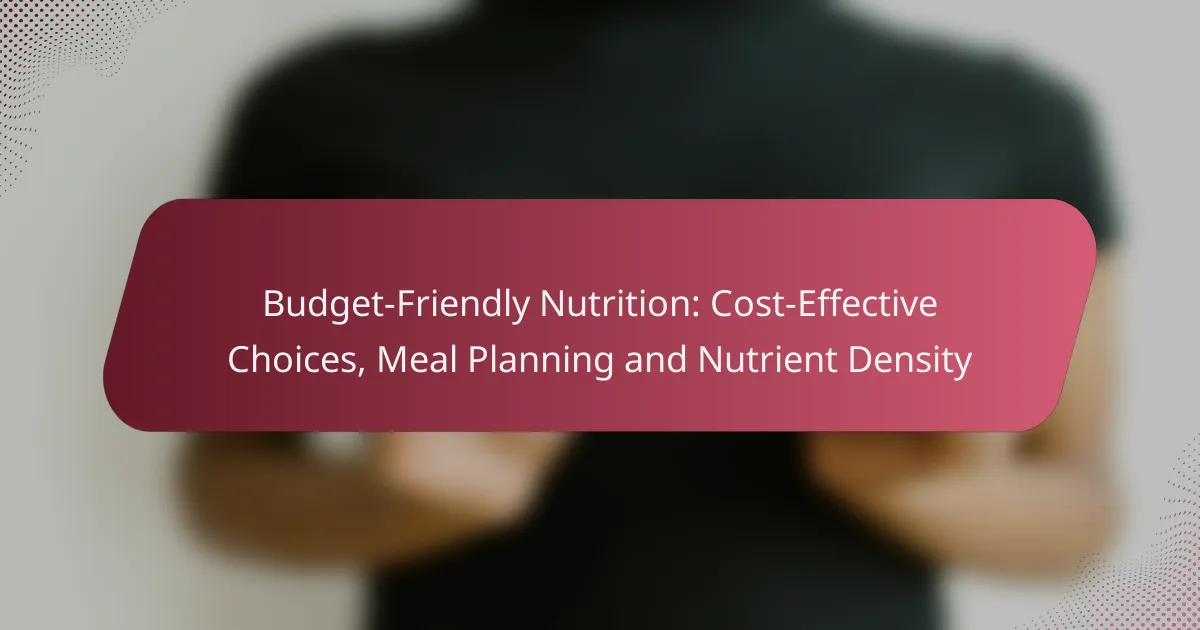Eating healthy on a budget is entirely possible by prioritizing nutrient-dense foods and making informed choices. By planning meals around seasonal produce and sales, as well as considering bulk purchases, you can stretch your food budget further. Implementing cost-effective meal planning strategies will help you maximize nutrition while minimizing expenses, ensuring that you maintain a healthy diet without overspending.

How can I eat healthy on a budget in Ireland?
Eating healthy on a budget in Ireland is achievable by making strategic choices that prioritize nutrient-dense foods while minimizing costs. Focus on seasonal produce, plan meals around sales, and consider bulk purchases to maximize your food budget.
Utilize seasonal produce
Seasonal produce is often more affordable and fresher than out-of-season options. In Ireland, fruits and vegetables like apples, carrots, and cabbage are typically cheaper during their harvest months. Incorporating these items into your meals can enhance nutrition while keeping costs low.
Visit local markets or grocery stores to find deals on seasonal items. Planning your meals around what’s in season can lead to significant savings and a more varied diet.
Plan meals around sales
Monitoring weekly sales and promotions can help you plan meals that take advantage of discounted items. Check local supermarket flyers for deals on meats, dairy, and pantry staples. By aligning your meal planning with these sales, you can reduce your grocery bill substantially.
Consider creating a flexible meal plan that allows you to substitute ingredients based on what’s on sale. This approach not only saves money but also encourages creativity in the kitchen.
Buy in bulk
Purchasing items in bulk can lead to significant savings, especially for non-perishable goods like grains, legumes, and canned products. Look for bulk bins in supermarkets or consider joining a wholesale club to access lower prices on larger quantities.
When buying in bulk, ensure you have adequate storage space and plan to use the items before they expire. This strategy is particularly effective for staples that are versatile and can be used in various recipes.
Incorporate plant-based proteins
Plant-based proteins, such as lentils, beans, and chickpeas, are often cheaper than meat and provide essential nutrients. Including these foods in your diet can help reduce costs while maintaining a healthy protein intake.
Try replacing meat with plant-based options in some meals. For example, a lentil stew can be a hearty and affordable alternative to a meat-based dish, allowing you to stretch your budget further.
Use coupons and discounts
Utilizing coupons and discount apps can significantly lower your grocery expenses. Many supermarkets in Ireland offer loyalty programs that provide discounts or points for future purchases. Keep an eye out for digital coupons and special promotions.
Before shopping, check websites or apps for available coupons for the items you plan to buy. Combining these discounts with sales can maximize your savings and help you stick to your budget.

What are cost-effective meal planning strategies?
Cost-effective meal planning strategies involve organizing meals and grocery shopping to maximize nutrition while minimizing expenses. By focusing on preparation and smart shopping, you can significantly reduce food costs without sacrificing quality.
Create a weekly meal plan
Creating a weekly meal plan helps you decide what to eat in advance, reducing impulse purchases and food waste. Start by selecting recipes that utilize similar ingredients, which can help you buy in bulk and save money.
Consider planning meals that include a variety of proteins, grains, and vegetables to ensure balanced nutrition. For example, you might plan chicken stir-fry, lentil soup, and vegetable pasta throughout the week, using overlapping ingredients like bell peppers and onions.
Prep meals in advance
Meal prepping involves cooking and portioning meals ahead of time, which can save time and reduce the temptation to order takeout. Dedicate a few hours each week to prepare meals that can be stored in the refrigerator or freezer.
For instance, you can cook a large batch of quinoa and roast a variety of vegetables, then combine them in different ways throughout the week. This approach not only saves money but also ensures you have healthy options readily available.
Make a shopping list
Making a shopping list is essential for sticking to your budget and avoiding unnecessary purchases. Before heading to the store, review your meal plan and list all the ingredients needed, focusing on whole foods and seasonal produce.
Try to categorize your list by sections of the store, such as produce, grains, and proteins, to streamline your shopping experience. This method can help you stay organized and minimize impulse buys, ultimately leading to better savings.

Which nutrient-dense foods are budget-friendly?
Nutrient-dense foods that are budget-friendly provide essential vitamins and minerals without straining your wallet. By focusing on these options, you can maintain a healthy diet while keeping costs low.
Lentils and beans
Lentils and beans are excellent sources of protein, fiber, and various nutrients, making them a staple in budget-friendly nutrition. They are often available in dried or canned forms, with dried varieties typically being more economical.
Incorporating lentils and beans into meals can be as simple as adding them to soups, stews, or salads. A common tip is to buy in bulk, which can further reduce costs, especially for dried options.
Frozen vegetables
Frozen vegetables are a cost-effective way to add nutrients to your meals without worrying about spoilage. They are usually flash-frozen at peak ripeness, preserving their nutritional value and flavor.
When selecting frozen vegetables, look for options without added sauces or seasonings to keep them healthy. They can be easily added to stir-fries, casseroles, or served as side dishes, providing versatility and convenience.
Whole grains
Whole grains, such as brown rice, quinoa, and oats, are nutrient-dense and affordable options that provide fiber and essential nutrients. They are often less expensive when purchased in bulk or as store brands.
To maximize their benefits, consider meal prepping with whole grains. Cook a large batch and use them throughout the week in various dishes, from breakfast bowls to hearty salads.
Eggs
Eggs are a highly nutritious and budget-friendly protein source, rich in vitamins and minerals. They are versatile and can be prepared in numerous ways, making them a convenient option for any meal.
Buying eggs in larger quantities can reduce the cost per egg. Consider incorporating them into breakfast, lunch, or dinner recipes, such as omelets, frittatas, or even baked goods, to enhance your meals economically.

How do I compare prices for grocery shopping?
To effectively compare prices for grocery shopping, utilize various tools and resources that provide insights into pricing across different stores. This approach helps you identify the best deals and make informed purchasing decisions, ultimately saving you money.
Use price comparison apps
Price comparison apps allow you to scan barcodes or search for products to see prices at various retailers. Popular apps like Flipp or Basket can help you track prices in real-time, making it easier to find the best deals. Regularly check these apps to stay updated on discounts and promotions.
When using these apps, consider the total cost, including any potential shipping fees or membership costs associated with certain stores. This will give you a clearer picture of the actual savings.
Check local flyers
Local grocery store flyers are a valuable resource for comparing prices on specific items. Most stores release weekly flyers that highlight sales and promotions, allowing you to plan your shopping list accordingly. Look for flyers in newspapers or online on the stores’ websites.
Take note of the items that are on sale and consider creating a meal plan based on these discounts. This strategy can help you maximize savings while ensuring you purchase nutritious ingredients.
Visit discount stores
Discount stores often offer lower prices on groceries compared to traditional supermarkets. Stores like Aldi or Lidl provide a range of products at competitive prices, making them a great option for budget-conscious shoppers. Be sure to compare the quality of products as well, as some discount stores may have different brands or packaging.
When shopping at discount stores, keep an eye out for bulk items or store-brand products, which can further reduce costs. Planning your shopping trips around these stores can lead to significant savings over time.

What are the benefits of meal prepping?
Meal prepping offers numerous benefits, including saving time and money while promoting healthier eating habits. By planning and preparing meals in advance, individuals can ensure they have nutritious options readily available, reducing the temptation to choose less healthy convenience foods.
Time Efficiency
Meal prepping significantly reduces the time spent cooking during the week. By dedicating a few hours on the weekend to prepare meals, you can streamline your daily routine and avoid the stress of last-minute cooking. This approach can save you several hours each week, allowing for more free time.
To maximize time efficiency, consider batch cooking staple ingredients like grains, proteins, and vegetables. For instance, cooking a large batch of quinoa or grilled chicken can provide versatile components for various meals throughout the week.
Cost Savings
Meal prepping can lead to substantial cost savings by minimizing food waste and allowing for bulk purchasing. When you plan meals, you can buy ingredients in larger quantities, often at a lower price per unit. This strategy can help you stay within a budget while ensuring you have nutritious meals available.
For example, purchasing a whole chicken instead of individual cuts can be more economical. You can use the entire bird for multiple meals, reducing overall grocery expenses. Additionally, using seasonal produce can further enhance savings.
Nutrient Density
Focusing on nutrient density is crucial when meal prepping, as it ensures that the meals you prepare are rich in vitamins and minerals. By selecting whole foods, such as fruits, vegetables, whole grains, and lean proteins, you can create balanced meals that support overall health.
Incorporate a variety of colors and food groups into your meal prep to maximize nutrient intake. For instance, a colorful stir-fry with bell peppers, broccoli, and carrots not only looks appealing but also provides a range of essential nutrients. Aim for meals that include protein, healthy fats, and fiber for optimal nutrition.
Portion Control
Meal prepping helps with portion control, which can be beneficial for maintaining a healthy weight. By pre-portioning meals into containers, you can avoid overeating and ensure that you consume appropriate serving sizes. This practice can help you stay mindful of your caloric intake.
Using clear containers can also aid in visualizing portion sizes. For example, a standard serving of cooked rice is about half a cup, which can be easily measured and stored in a container for quick access during the week. This method promotes consistency in your eating habits.
